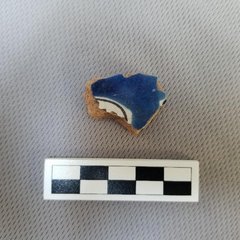This ceramic shard recovered from the excavations inside the Long Barrack represents one of the earlier varieties of a Spanish Colonial tin-glazed ware, also referred to as a majolica. Puebla Polychrome was manufactured in Mexico likely during the second half of the seventeenth century until approximately 1725.
The design motif was thought to represent Talavera styles that were produced in Spain. The Puebla Polychrome type has a distinctive “cobweb” design in black and white, with large areas of blue. This type is more often encountered at the earliest occupied Spanish Colonial sites in San Antonio, including Mission San Antonio de Valero, Presidio de Bexar, and the early civilian sites associated with Villa de Bexar.



